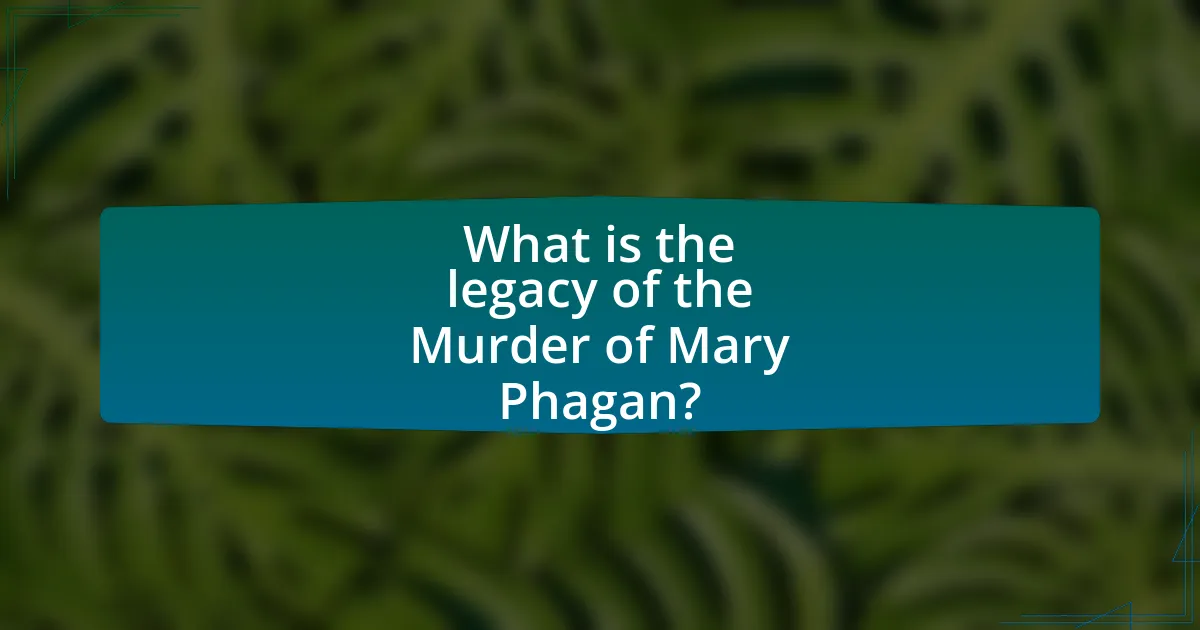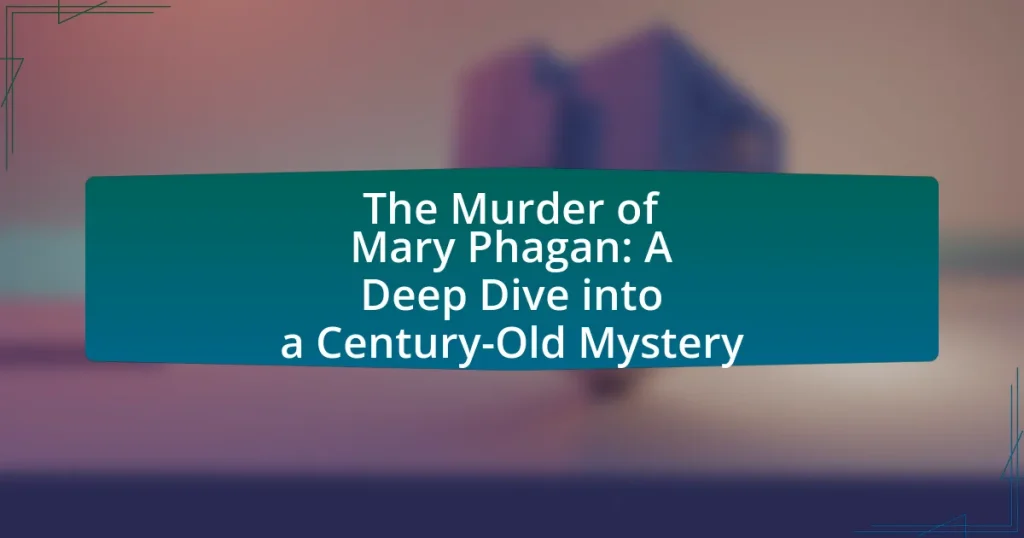The article focuses on the murder of Mary Phagan, a 13-year-old girl who was killed in Atlanta, Georgia, in 1913, and the subsequent trial of Leo Frank, the factory superintendent accused of her murder. It details the circumstances surrounding Phagan’s death, the community’s reaction, and the legal proceedings that followed, highlighting issues of anti-Semitism and social injustice. The article also examines the evidence presented during the trial, the influence of public opinion and media coverage, and the eventual lynching of Frank in 1915. Additionally, it discusses the legacy of the case, its impact on American society, and the lessons learned regarding justice and bias in the legal system.

What happened in the Murder of Mary Phagan?
Mary Phagan was murdered on April 26, 1913, in Atlanta, Georgia, after leaving her workplace at the National Pencil Company. Her body was discovered in the factory’s basement, leading to the arrest of Leo Frank, the factory’s superintendent. Frank was tried and convicted largely based on the testimony of a factory worker, Jim Conley, who claimed to have helped dispose of the body. The case garnered national attention, highlighting issues of anti-Semitism and legal injustice. Frank’s conviction was later commuted, but he was lynched by a mob in 1915, reflecting the intense public sentiment surrounding the case.
Who was Mary Phagan and why is her murder significant?
Mary Phagan was a 13-year-old girl who was murdered in 1913 in Atlanta, Georgia. Her murder is significant because it led to a highly publicized trial of Leo Frank, a Jewish factory manager, which highlighted issues of anti-Semitism and social injustice in the American South. The case garnered national attention, influencing public opinion and ultimately leading to Frank’s lynching in 1915, which underscored the racial and social tensions of the era.
What were the circumstances surrounding Mary Phagan’s death?
Mary Phagan was murdered on April 26, 1913, in Atlanta, Georgia, after leaving her workplace at the National Pencil Company. The circumstances of her death involved her being found in the factory basement, where she had been sexually assaulted and strangled. Evidence indicated that she had been attacked shortly after she left the factory, and the subsequent investigation led to the arrest of Leo Frank, the factory’s superintendent. Frank was later convicted based on controversial evidence, including testimony from a factory worker, which sparked widespread debate and ultimately led to his lynching in 1915.
How did the community react to her murder?
The community reacted with outrage and grief to Mary Phagan’s murder. Following the discovery of her body in 1913, residents of Marietta, Georgia, expressed their anger through protests and public gatherings, demanding justice. The local newspapers fueled the sentiment by publishing sensationalized accounts of the crime, which heightened public interest and concern. This collective response reflected the community’s desire for accountability and highlighted the racial tensions of the time, as the case involved Leo Frank, a Jewish factory manager accused of the murder. The intense public scrutiny and media coverage ultimately led to a highly publicized trial and subsequent lynching, demonstrating the profound impact of the murder on the community’s social dynamics.
What were the key events leading up to the murder?
The key events leading up to the murder of Mary Phagan include her visit to the National Pencil Company on April 26, 1913, to collect her paycheck. After leaving the factory, she was last seen alive around 12:05 PM. Shortly after her departure, Phagan was reported missing, prompting a search that culminated in her body being discovered in the factory’s basement later that day. The investigation revealed that she had been brutally murdered, with evidence suggesting she had been assaulted. These events set the stage for the subsequent arrest of Leo Frank, the factory’s superintendent, who became the primary suspect in the case.
What was Mary Phagan’s life like before her death?
Mary Phagan’s life before her death was characterized by her role as a young factory worker in Atlanta, Georgia, where she was employed at the National Pencil Company. At just 13 years old, she contributed to her family’s income, reflecting the economic conditions of the time that often required children to work. Phagan was described as a lively and sociable girl, known for her friendly demeanor and interactions with peers. Her life was marked by the challenges of working-class existence in the early 20th century, which included long hours and low wages typical for young female workers in factories. The circumstances surrounding her life and work set the stage for the tragic events that followed her murder in April 1913.
What role did the factory where she worked play in the events?
The factory where Mary Phagan worked played a crucial role in the events surrounding her murder by serving as the location where she was last seen alive. Phagan was employed at the National Pencil Company in Atlanta, Georgia, and her murder on April 26, 1913, occurred shortly after she had collected her paycheck from the factory. The factory’s management, particularly Leo Frank, who was the factory superintendent, became a focal point of the investigation. Evidence and testimonies linked the factory to the timeline of her disappearance and subsequent murder, leading to Frank’s arrest and trial. The factory’s involvement not only highlighted the social and labor dynamics of the time but also intensified public scrutiny and media coverage, which played a significant role in shaping the narrative of the case.
Who were the main suspects in the case?
The main suspects in the murder of Mary Phagan were Leo Frank, the factory superintendent, and Jim Conley, a factory worker. Leo Frank was accused based on circumstantial evidence and his behavior following the crime, while Jim Conley provided testimony that implicated Frank, claiming he helped dispose of the body. The case garnered significant media attention and public scrutiny, leading to a highly controversial trial that ultimately resulted in Frank’s conviction.
What evidence was presented against Leo Frank?
The evidence presented against Leo Frank included testimony from several witnesses, particularly that of Jim Conley, a factory worker who claimed to have seen Frank with Mary Phagan on the day of her murder. Conley alleged that Frank had instructed him to help dispose of the body. Additionally, the prosecution highlighted inconsistencies in Frank’s statements during police interrogations, which raised suspicions about his involvement. The presence of bloodstains and the location of Phagan’s body in the factory basement further contributed to the circumstantial evidence against him. These elements collectively formed the basis for the conviction that led to Frank’s sentencing.
How did public opinion influence the investigation?
Public opinion significantly influenced the investigation into the murder of Mary Phagan by creating immense pressure on law enforcement and the judicial system. The widespread outrage and media coverage surrounding the case led to a heightened urgency to solve the crime, which in turn affected the methods and focus of the investigation. For instance, the intense scrutiny from the public and press contributed to the arrest of Leo Frank, despite the lack of substantial evidence against him, as authorities sought to appease public sentiment. This phenomenon illustrates how societal emotions can shape investigative priorities and outcomes, often leading to rushed conclusions rather than thorough examinations of the evidence.

What were the legal proceedings following the murder?
Following the murder of Mary Phagan, legal proceedings included the arrest of Leo Frank, the factory superintendent, who was charged with her murder. The trial commenced on July 28, 1913, in Fulton County, Georgia, where the prosecution presented evidence and testimonies against Frank, while the defense argued for his innocence. The jury ultimately convicted Frank on August 25, 1913, sentencing him to death. This conviction was later upheld by the Georgia Supreme Court, despite numerous appeals and claims of a biased trial. The case drew significant public attention and controversy, leading to further legal battles, including a commutation of his sentence by Governor John M. Slaton in 1915, which was met with public outrage and resulted in Frank being lynched by a mob in 1915.
How did the trial of Leo Frank unfold?
The trial of Leo Frank unfolded with significant public attention and controversy, beginning on July 28, 1913, and lasting until August 25, 1913. Frank, a Jewish factory manager, was accused of murdering 13-year-old Mary Phagan in April 1913. The prosecution relied heavily on the testimony of Jim Conley, a factory worker, who claimed to have witnessed Frank’s involvement in the crime. Despite the lack of physical evidence linking Frank to the murder, the trial was marked by sensationalist media coverage and a biased atmosphere fueled by anti-Semitic sentiments. Ultimately, Frank was convicted and sentenced to death, a verdict that was met with widespread protests and calls for justice, leading to his eventual commutation to life imprisonment in 1915. The trial’s proceedings and the subsequent public outcry highlighted deep societal divisions and issues of justice in early 20th-century America.
What were the major arguments presented by the prosecution?
The major arguments presented by the prosecution in the murder of Mary Phagan included the assertion that Leo Frank, the factory superintendent, had the motive and opportunity to commit the crime. The prosecution argued that Frank had a history of inappropriate behavior towards young girls, which established a pattern of predatory conduct. Additionally, they presented evidence such as witness testimonies that placed Frank at the scene of the crime and highlighted inconsistencies in his alibi. The prosecution also emphasized the physical evidence, including the discovery of Mary Phagan’s body in the factory basement, which they claimed linked Frank directly to the murder.
What defense strategies were employed during the trial?
During the trial for the murder of Mary Phagan, the defense employed several strategies, including the argument of reasonable doubt and the presentation of character witnesses. The defense aimed to establish that there was insufficient evidence to conclusively link Leo Frank to the crime, emphasizing inconsistencies in witness testimonies and the lack of physical evidence. Additionally, character witnesses testified to Frank’s good reputation and moral standing in the community, attempting to portray him as an unlikely perpetrator of such a crime. These strategies were intended to create doubt in the minds of the jurors regarding Frank’s guilt.
What was the outcome of the trial?
The outcome of the trial was a conviction of Leo Frank for the murder of Mary Phagan. The trial, which took place in 1913, resulted in Frank being sentenced to death based on circumstantial evidence and testimonies that were later criticized for their reliability. The case drew significant public attention and controversy, leading to Frank’s eventual lynching in 1915, which highlighted issues of anti-Semitism and mob justice in the United States.
How did the verdict impact Leo Frank’s life?
The verdict in Leo Frank’s trial, which resulted in a conviction for the murder of Mary Phagan, drastically altered his life by leading to his lynching in 1915. Following the guilty verdict, Frank faced immense public outrage and hostility, particularly from anti-Semitic groups, which culminated in his abduction from prison and subsequent murder by a mob in Marietta, Georgia. This event not only ended Frank’s life but also sparked significant national discourse on anti-Semitism and the flaws in the American judicial system, highlighting the severe consequences of a biased legal process.
What were the reactions to the trial’s outcome?
The reactions to the trial’s outcome were highly polarized, reflecting deep societal divisions. Many in the Jewish community, particularly those connected to Leo Frank, expressed outrage and disbelief at the verdict, viewing it as a miscarriage of justice influenced by anti-Semitism. Conversely, a significant portion of the local population, fueled by prevailing racial and social tensions, celebrated the conviction, believing it served justice for Mary Phagan’s murder. This division was evident in public demonstrations and media coverage, with some newspapers advocating for Frank’s lynching, while others called for a fair reevaluation of the evidence. The trial’s outcome not only intensified existing prejudices but also sparked debates about the legal system’s integrity in the face of public opinion.

What is the legacy of the Murder of Mary Phagan?
The legacy of the Murder of Mary Phagan includes significant impacts on the American legal system, race relations, and public awareness of child labor issues. The case, which involved the murder of a 13-year-old girl in 1913 and the subsequent trial of Leo Frank, highlighted the deep-seated anti-Semitism in the South and led to Frank’s lynching in 1915, which became a pivotal moment in the history of civil rights. Additionally, the case spurred reforms in labor laws, particularly concerning child labor, as it drew national attention to the exploitation of children in factories. The events surrounding Phagan’s murder and Frank’s trial also contributed to the revival of the Ku Klux Klan, illustrating the intersection of crime, social justice, and racial tensions in early 20th-century America.
How has this case influenced public perception of justice?
The case of Mary Phagan’s murder significantly influenced public perception of justice by highlighting systemic flaws in the legal system, particularly regarding race and class biases. The trial of Leo Frank, a Jewish factory manager accused of her murder, revealed deep-seated anti-Semitism and raised questions about the fairness of the judicial process. Public outrage over the perceived miscarriage of justice led to widespread protests and ultimately to Frank’s lynching in 1915, which underscored the dangers of mob mentality and the failure of legal protections. This case remains a pivotal example of how societal prejudices can distort the pursuit of justice, shaping ongoing discussions about equity in the legal system.
What role did media play in shaping the narrative of the case?
Media played a crucial role in shaping the narrative of the murder case of Mary Phagan by influencing public perception and framing the discourse surrounding the trial. The extensive coverage by newspapers, particularly the Atlanta Journal and the Atlanta Constitution, created a sensationalized portrayal of the events, often emphasizing racial tensions and sensational details that captivated the public’s attention. This coverage not only swayed public opinion against Leo Frank, the accused, but also contributed to a climate of fear and outrage that ultimately led to his lynching in 1915. The media’s focus on specific narratives, such as the alleged brutality of the crime and the character of the accused, significantly impacted the judicial process and the societal response to the case.
How has the case been remembered in American history?
The case of the Murder of Mary Phagan has been remembered in American history as a pivotal moment that highlighted issues of racial injustice, anti-Semitism, and the complexities of the American legal system. The trial of Leo Frank, a Jewish factory manager accused of her murder, became a national spectacle, reflecting societal tensions in the early 20th century. The case is often cited as a catalyst for the resurgence of the Ku Klux Klan and has been analyzed in numerous historical studies, such as “The Leo Frank Case: The Lynching of a Jew” by Leonard Dinnerstein, which details the anti-Semitic sentiments that influenced public opinion and the legal proceedings. This case remains a significant reference point in discussions about race, justice, and media influence in America.
What lessons can be learned from the Murder of Mary Phagan?
The murder of Mary Phagan teaches critical lessons about the dangers of mob mentality and the impact of racial prejudice on justice. The case, which involved the wrongful conviction of Leo Frank, highlights how public opinion can sway legal outcomes, often leading to unjust results. Historical records indicate that the trial was heavily influenced by anti-Semitic sentiments, demonstrating how societal biases can distort the pursuit of truth and fairness in the judicial system. Additionally, the case underscores the importance of due process and the need for thorough investigations, as the rush to judgment can lead to tragic consequences.
How can modern investigations benefit from this historical case?
Modern investigations can benefit from the historical case of the Murder of Mary Phagan by utilizing advanced forensic techniques and understanding the social and legal context of the time. The case highlights the importance of evidence collection and the impact of public opinion on judicial processes, which can inform current practices in handling sensitive investigations. For instance, the Phagan case involved significant media coverage that influenced the trial’s outcome, demonstrating the need for investigators today to manage public perception while ensuring a fair process. Additionally, lessons learned from the investigative shortcomings of the past, such as the reliance on circumstantial evidence and the handling of witness testimonies, can guide contemporary methods to improve accuracy and justice in modern criminal investigations.
What practices can be implemented to prevent similar injustices?
To prevent similar injustices as seen in the murder of Mary Phagan, implementing comprehensive legal reforms is essential. These reforms should include establishing stricter guidelines for evidence collection and ensuring that all investigations are conducted transparently and impartially. Historical cases, such as the wrongful conviction of Leo Frank in the Phagan case, highlight the dangers of biased investigations and the influence of public opinion on judicial outcomes. Additionally, training law enforcement and judicial personnel on bias recognition and ethical standards can mitigate the risk of prejudice affecting case outcomes. Implementing community oversight boards can also enhance accountability in law enforcement practices, ensuring that community voices are heard and considered in the justice process.


